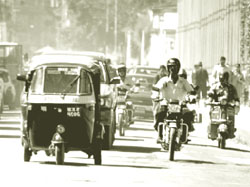Trouble in the air
 the Nepalese government's decision to ban vehicles older than 20 years has been met with stiff opposition. On February 2, traffic came to a standstill in various parts of Kathmandu after transporters took to the streets. Again on February 9, the National Federation of Transport Entrepreneurs organised a protest rally. The government has decided to ban vehicles older than 20 years and those with two-stroke engines from mid-November 2001. There are more than 100,000 two-stroke powered vehicles in Nepal. Earlier, the government had banned the polluting diesel-run Vikram tempos from Kathmandu valley in September 1999. They have been replaced by battery-operated three-wheelers, also called safa tempos.
the Nepalese government's decision to ban vehicles older than 20 years has been met with stiff opposition. On February 2, traffic came to a standstill in various parts of Kathmandu after transporters took to the streets. Again on February 9, the National Federation of Transport Entrepreneurs organised a protest rally. The government has decided to ban vehicles older than 20 years and those with two-stroke engines from mid-November 2001. There are more than 100,000 two-stroke powered vehicles in Nepal. Earlier, the government had banned the polluting diesel-run Vikram tempos from Kathmandu valley in September 1999. They have been replaced by battery-operated three-wheelers, also called safa tempos.
The government's decision has drawn flak from transporters. "We will be badly affected if the government enforces this decision,' said Sarad Upreti, president of the Federation of Nepalese Transport Entrepreneurs.
Meanwhile, six non-government organisations (ngos) have endorsed the government's decision and want the government to go ahead with its implementation. These include Leaders Nepal, Martin Chautari, The Explore Nepal Group, Pro Public, Clean Energy and the Citizen's Monitoring Group.
Vehicle operators in Kathmandu want the government to ban imported automobiles that operate as commercial vehicles in Nepal. They also want the government to stop their import. Their argument is that vehicles pollute not because they are old, but because of the poor quality of fuel. According to The Kathmandu Post, a government report corroborated that fuel was sold with as much as 65 per cent adulterants.
Meanwhile, the kingdom is also facing severe shortage of liquified petroleum gas (lpg). Three reasons have been cited for the shortage. Firstly, the government has recently raised the prices of petroleum products, including kerosene that was raised by 100 per cent. As a result, many switched to lpg for cooking purposes. Secondly, lpg-run vehicles as well as industries consume a large amount of the gas. There are over 1,000 vehicles in Nepal that run on lpg
Related Content
- Report by the District Mineral Officer, Baramulla on gypsum mining affecting the health of villagers, 11/09/2023
- Order of the National Green Tribunal regarding illegal disposal of bio medical waste in village Mohanpur, district Ashoknagar, Madhya Pradesh, 08/02/2023
- Panipat Thermal Power Station dumping fly ash illegally: NGT directs the committee to look into the matter
- Africa in the new trade environment: market access in troubled times
- Cost of a plate of food 2020
- Violence without Borders: The Internationalization of Crime and Conflict
